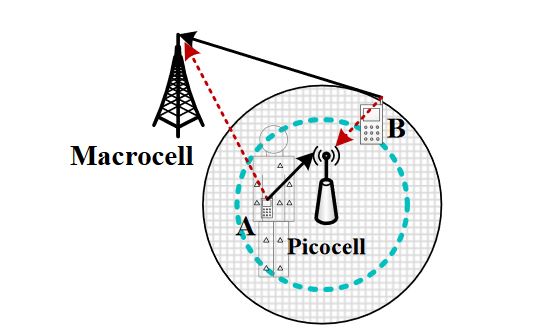ABSTRACT
With the rapid development of wireless networking technologies, the Internet of Things and heterogeneous cellular networks (HCNs) tend to be integrated to form a promising wireless network paradigm for 5G. Hyper-dense sensor and mobile devices will be deployed under the coverage of heterogeneous cells, so that each of them could freely select any available cell covering it and compete for resource with others selecting the same cell, forming a cell selection (CS) game between these devices. Since different types of cells usually share the same portion of the spectrum, devices selecting overlapped cells can experience severe inter-cell interference (ICI). In this article, we study the CS game among a large amount of densely-deployed sensor and mobile devices for their uplink transmissions in a two-tier HCN.
ICI is embedded with the traditional congestion game (TCG), forming a congestion game with ICI (CGI) and a congestion game with capacity (CGC). For the three games above, we theoretically find the circular boundaries between the devices selecting the macrocell and those selecting the picocells, indicated by the pure strategy Nash equilibria (PSNE). Meanwhile, through a number of simulations with different picocell radii and different path loss exponents, the collapse of the PSNE impacted by severe ICI (i.e., a large number of picocell devices change their CS preferences to the macrocell) is profoundly revealed, and the collapse points are identified.
RELATED WORKS
Studies on CS can be traced back to the era of homogeneous networks, such as the work by Hanly, Zhang and Letaief, Sang et al etc. The issue becomes much more complicated when it is in a heterogeneous environment due to the multi-attribute feature of various access technologies and cells. For a heterogeneous wireless network environment composed of WiFi, cellular access technology, personal area networks, etc., NS has been widely studied. Optimization techniques, such as multi-attribute decision making, fuzzy logic and utility theory, have been used for deciding the best network to access. Game theory was also used to study the competition between users for accessing these networks.
SYSTEM MODEL

Figure 2. System model. Each picocell holds a circular boundary
System model. Each picocell holds a circular boundary (i.e., the azure dashed circle) indicating the PSNE. Device A is inside the boundary, so it transmits to the picocell and interferes with the macrocell. Although Device B is within the edge of the picocell, it is outside of the dashed circle, so it selects the macrocell and interferes with the picocell.
CELL SELECTION GAMES
Since picocells usually have a small coverage and are deployed at hotspots for complementation, we assume that their coverage areas are independent of one another. In this scenario, we are interested in n∗i, the number of devices selecting BSi in the PSNE.
PERFORMANCE EVALUATION

Figure 5. Verification of the theorems. (a) Theorem 1; (b) Theorem 2; (c) Theorem 3
In this section, we provide extensive simulations by MATLAB to demonstrate the correctness of the theorems and the impact of ICI on the PSNE for the CS games with a large amount of densely-deployed devices in HCNs. The simulation area is a single macrocell with a radius equaling 1000 m. A small number of picocells are almost randomly deployed within the coverage of the macrocell, but assuming that they do not overlap with one another. This is achieved by randomly choosing the picocells locations one-by-one and making sure each one is not overlapped with those already deployed.
CONCLUSIONS
HCNs and IoT have been considered to form a new wireless network paradigm to evolve the mobile communication system toward 5G, while the CS game among densely-deployed sensor and mobile devices in HCNs became one of the key issues and challenges. For a CS game undergoing severe ICI, the congestion game model was found to be a suitable methodology for this study. In this article, we embedded ICI into the congestion game and theoretically identified the PSNE with three theorems. The closed-form expression for the ICI was calculated and helped validate the three theorems. We conclude that, on the one hand, the CS game among a large amount of densely-deployed devices can be considered from the statistical point of view by integrals, which made this game able to be solved with closed-form expressions.
On the other hand, the PSNE of such a game may suddenly collapse to the macrocell under the impact of severe ICI, and the system performance, in terms of average spatial spectral efficiency, could be severely degraded by this collapse phenomenon. Therefore, this study should be quite helpful to design the future CS scheme for dense devices in an integrated environment with HCNs and IoT. Our future work involves the design of a CS scheme fitting for generalized scenarios, such as different traffic types, device types and user preferences, as well as device mobility. Meanwhile, we will theoretically consider a more generalized cell deployment, i.e., the irregular deployment of BSs with Voronoi cell boundaries.
Source: Hefei University
Authors: Lusheng Wang | Yamei Wang | Zhizhong Ding | Xiumin Wang
>> Top IoT Projects using Matlab for B.E/B.Tech Students
>> 200+ IoT Led Projects for Final Year Students
>> IoT based Networking Projects for Engineering Students
>> More Matlab Projects based on Wireless Communication for Engineering Students